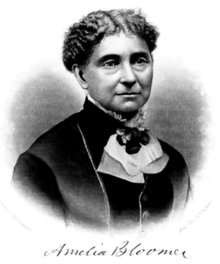Amelia Bloomer
| Amelia Bloomer | |
|---|---|
 |
|
| Born | May 27, 1818 Homer, New York, United States |
| Died | December 30, 1894 (aged 76) Council Bluffs, Iowa, United States |
| Residence | Amelia Bloomer House |
| Occupation | Women's rights and temperance advocate |
Amelia Bloomer (May 27, 1818 – December 30, 1894) was an American women's rights and temperance advocate. Even though she did not create the women's clothing reform style known as bloomers, her name became associated with it because of her early and strong advocacy.
Amelia Bloomer was born in 1818 in Homer, New York. Bloomer came from a family of modest means and received only a few years of formal education in the local district school. After a brief stint as a school teacher at the age of 17, she decided to relocate, and moved in with her newly married sister Elvira, then living in Waterloo. Within a year she had moved into the home of the Oren Chamberlain family to act as the live-in governess for their three youngest children.
When she was 22, she married attorney Dexter Bloomer who encouraged her to write for his New York newspaper, the Seneca Falls County Courier.
She spent her early years in Cortland County, New York. Bloomer and her family moved to Iowa in 1852. She died at Council Bluffs, Iowa. She is commemorated together with Elizabeth Cady Stanton, Sojourner Truth, and Harriet Ross Tubman in the calendar of saints of the Episcopal Church on July 20. Her home at Seneca Falls, New York, known as the Amelia Bloomer House, was listed on the National Register of Historic Places in 1980.
In 1848, Bloomer attended the Seneca Falls Convention, the first women's rights convention. The following year, she began editing the first newspaper for women, The Lily. It was published biweekly from 1849 until 1853. The newspaper began as a temperance journal, but came to have a broad mix of contents ranging from recipes to moralist tracts, particularly when under the influence of activist and suffragette Elizabeth Cady Stanton and Susan B. Anthony. Bloomer felt that because women lecturers were considered unseemly, writing was the best way for women to work for reform. Originally, The Lily was to be for “home distribution” among members of the Seneca Falls Ladies Temperance Society, which had formed in 1848, and eventually had a circulation of over 4,000. The paper encountered several obstacles early on, and the Society’s enthusiasm died out. Bloomer felt a commitment to publish and assumed full responsibility for editing and publishing the paper. Originally, the title page had the legend “Published by a committee of ladies.” But after 1850 – only Bloomer’s name appeared on the masthead. This newspaper was a model for later periodicals focused on women's suffrage.
...
Wikipedia
